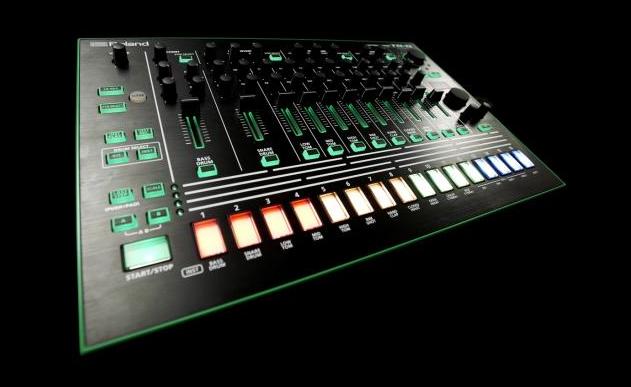The “new” 808 successor from Roland will be modeled in digital form, possibly using virtual analog modeling, and perhaps with some sample sources. Roland’s Aira-08, as readers noted, is already leaking in product descriptions as a “virtual analog” synth. (Among other sources: there was a Dutch retailer that revealed the info, before removing the page.) Unless Roland has managed some epic disinformation campaign, that means you won’t see an analog remake as KORG did with their MS-20 last year. What you should expect instead is one that uses digital models to capture the sound of its predecessor, in a new design. We’re even hearing from sources that it’s in fact a SuperNATURAL-derived synth, as I speculated yesterday. (But that was almost certain, anyway.)
So let’s consider for a moment what a modeled 808 from Roland would look like, at least while we wait to talk to them about specifics.
It’s worth looking at the most recent generation of emulated analog from Roland, SuperNATURAL. “SuperNATURAL” is simply catch-all marketing to describe a variety of Roland technologies. For acoustic instruments, this has to do with behavioral modeling, building a set of sound models that go beyond just looping PCM samples and the like. You can read Roland’s blog post on the topic, though it focuses on the acoustic:
What is SuperNATURAL Technology? [Roland Blog]
The results are very, very good, perhaps not exceeding what’s possible with big sample banks on computers, but certainly a leap forward in playability and expression for dedicated Roland hardware.
It’s not just acoustic instruments that get this moniker, though. In Roland’s virtual analog instruments, each analog SuperNATURAL sound is made up of a series of models of components, from oscillators to filters. For added confusion, “SuperNATURAL” may refer to voices that use PCM (sample) sound sources for oscillators. It would be nice to see Virtual Analog oscillators here, as they would seem well-suited to a drum machine. (PCM isn’t necessarily evil, as some comment threads would have you believe. But a modeled oscillator can offer more versatility in certain situations – as it can provide greater ranges of parameters to control. See, specifically, the Roland SH-201 I mentioned in yesterday’s article, which used virtual analog inherited from the Fantom.)
And those sounds are very good, too. Let’s take a moment to give Roland some credit. The recent Jupiters have some terrific analog engines in them, and the Aira will almost certainly use similar technology. Many electronic producers aren’t likely to go buy a Jupiter 80 or Jupiter 50, because these are workstation keyboards that are overkill for what you do. And the modeled acoustic instruments unfortunately distracted from some of the nicer work Roland did on the Jupiter’s VA components, associating those Jupiters with cheesy instrumental demos and not on the sound design and voicing underneath. For a good take on that, read Gordon Reid’s reviews for Sound on Sound. (David Lovelace also has a good review, focusing on its use as a stage keyboard, for the American Keyboard Magazine.)
These reviews take on new relevance as you can take what they say about the sound design for keyboards and apply it here to drum machines.
I was corrected by a reader that just because SuperNATURAL is described as “virtual analog” doesn’t mean there’s necessarily a model of a waveform; these oscillators may use PCM sample sources and a combination of layering and other component models to get the desired sound.
I am hopeful that what we’ll see on the Aira is a new architecture that is truly virtual analog.
The question now is just how much Roland has put into the modeling on the new instrument, and what that means for sound and playability. We’ll know soon enough. (There are some good signs. GearSlutz, who leaked this back in the fall, suggested collaborations with the likes of acid pioneer A Guy Called Gerald.)
I think if Roland can hit an affordable price with this, and if it’s reasonably playable, they’ll have a hit on their hands. And the form factor has a reasonably-nice layout, with big triggers.
The market should still be open for a faithful 808 clone, however. Producer Michel Morin, aka Sneak-Thief, reflected on this privately (and provided CDM permission to recall his thoughts). He deals with some of the more idiosyncratic features of the 808:
The big question if it’s modeled digitally: will it breathe like a real TR-808?
1. You see, the capacitors for the VCAs don’t always fully discharge before the instrument is next triggered which creates a kind of pumping effect. Also, the original clap circuit was poorly designed and you usually can’t hear the clap reverb on the first couple hits. Will they mimic this?
2. Some of the oscillators are free-running, meaning that the beginning of the waveform can differ each time the hats, cymbals and cowbell are triggered. Also, the kick drum uses a bridged T-resonator circuit – a fundamentally unstable analog arrangement where the trigger pings/excites the circuit which bursts into resonance then slowly fades. It’s a beautiful, natural & organic-sounding sound. Will this be emulated?
3. There are also many audible variations between drum hits due to the trigger circuits. Not only that, seeing as most of the original components have 5-20% tolerances, temperature changes create variations in the sound.
I don’t imagine these are important to Roland. Nor should they be important to someone who just wants a drum machine. They are important to people whose attraction to the 808 is to a specific instrument. The Aira, as Roland is already saying, is something new.
It’s not necessarily a bad thing. I am amused that people are criticizing Roland’s mid-1990s MC-303 groovebox, as that was a very nice instrument for its day. (It’s still a pretty good deal used.)
So if purists won’t be happy and people wanting a drum machine will, what about
